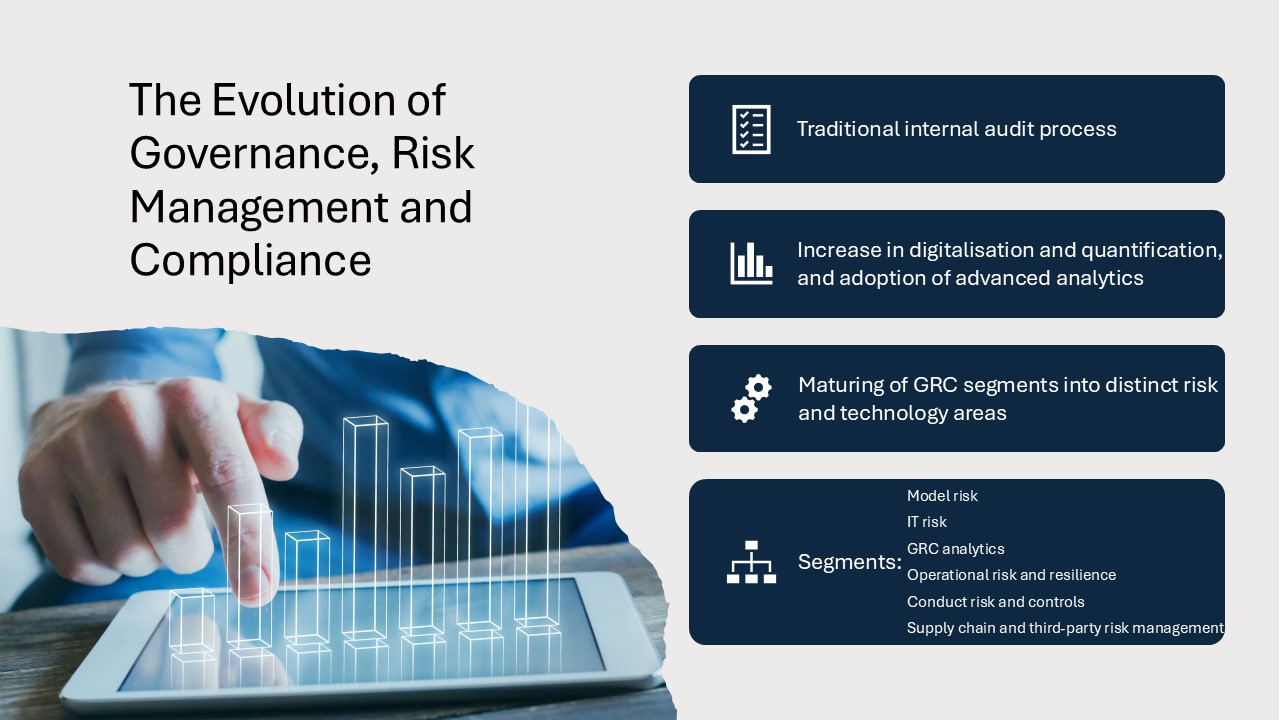Artificial Intelligence (AI) is reshaping the landscape of Governance, Risk, and Compliance (GRC), particularly in the realm of cybersecurity. As cyber threats grow in both sophistication and volume, traditional GRC frameworks often struggle to keep pace with the dynamic nature of risk. AI-powered tools and methodologies offer a more adaptive, data-driven approach that significantly enhances organisations' ability to anticipate, identify, and respond to cyber threats while ensuring regulatory compliance. The issue remains when regulators are not slowing down regulatory change or easing regulatory pressure. This can motivate organisations to adopt more effective and proactive GRC stances.

Figure 1: Evolution of Governance, Risk Management and Compliance. (Adapted from source: https://www.chartis-research.com/operational-risk/7947134/automation-and-ai-in-grc-regulatory-inventory-solutions-for-financial-services)
The Role of AI in Cybersecurity GRC
AI in GRC operates at the intersection of data analysis, pattern recognition, and decision-making. Machine learning (ML), natural language processing (NLP), and automation are key technologies being deployed across various aspects of cybersecurity GRC.
1. Automated Risk Assessment and Management
AI enables real-time risk identification and classification by analysing vast amounts of structured and unstructured data. Traditional risk assessments are periodic and manual, leaving organisations vulnerable between assessments. AI, however, continuously monitors networks and systems, identifying anomalies and flagging potential threats.
According to a report by Gartner, AI-driven risk management tools are expected to reduce cybersecurity incidents by 25% in organisations that implement them effectively by 2026 (Gartner, 2022).
2. Enhancing Regulatory Compliance
Staying compliant with ever-evolving regulations like ISO27001, ISO42001, PDPA, GDPR, HIPAA, and PCI DSS is a major challenge. AI simplifies compliance by automating policy updates, tracking regulatory changes, and auditing controls. Natural Language Processing (NLP) tools can read and interpret regulatory texts, mapping requirements to internal controls and policies.
In a study by McKinsey, AI-based compliance monitoring reduced manual workload by 50% while improving accuracy (McKinsey, 2023).
3. Improving Incident Response and Threat Detection
AI-driven systems enhance threat detection by recognising patterns that deviate from the norm. Behavioural analytics tools use ML to establish baselines of "normal" activity and detect deviations indicative of insider threats or breaches. These systems often detect threats that traditional signature-based methods miss.
IBM’s 2023 Cost of a Data Breach Report revealed that organisations leveraging AI and automation experienced a 74-day shorter breach lifecycle and saved $1.76 million on average compared to those without these capabilities (IBM, 2023).
4. Streamlining Audit and Reporting Processes
Audits are labor-intensive, especially in complex IT environments. AI can automate evidence collection, log analysis, and control testing. By using AI to correlate activities across systems, organisations can streamline internal and external audits, increasing transparency and reducing the risk of non-compliance.
Generative AI can take over knowledge and resource management by organising and retrieving audit resources on demand.
5. Continuous Control Monitoring
Continuous Control Monitoring (CCM) is an emerging AI use case in GRC, enabling real-time evaluation of compliance controls. AI enhances CCM by scanning logs, configurations, and user activities to detect control violations immediately.
A 2021 ISACA study emphasised that AI adoption in CCM increases control effectiveness and early detection of compliance gaps (ISACA, 2021).
Challenges and Considerations
Despite its promise, AI integration into GRC is not without challenges:
The Future of AI in GRC
As AI technologies evolve, they will continue to shape a more predictive, automated, and intelligent GRC ecosystem. We can expect a shift toward proactive risk management, where AI not only detects risks but predicts them before they materialise.
The role of AI in cybersecurity GRC is poised to expand significantly in the coming years, with emerging trends including:
Conclusion
AI is not a silver bullet, but it is a transformative force for cybersecurity Governance, Risk, and Compliance. It enables organisations to manage growing cyber threats, meet expanding regulatory demands, and strengthen digital trust with stakeholders. Through automation, intelligence, and contextual analysis, AI empowers GRC functions to evolve from static, reactive frameworks into dynamic, adaptive systems that anticipate and manage risk in real time.
Organisations that successfully integrate AI into their GRC strategies will be better positioned to navigate the digital risk landscape with agility, resilience, and confidence.
References:

Figure 1: Evolution of Governance, Risk Management and Compliance. (Adapted from source: https://www.chartis-research.com/operational-risk/7947134/automation-and-ai-in-grc-regulatory-inventory-solutions-for-financial-services)
The Role of AI in Cybersecurity GRC
AI in GRC operates at the intersection of data analysis, pattern recognition, and decision-making. Machine learning (ML), natural language processing (NLP), and automation are key technologies being deployed across various aspects of cybersecurity GRC.
1. Automated Risk Assessment and Management
AI enables real-time risk identification and classification by analysing vast amounts of structured and unstructured data. Traditional risk assessments are periodic and manual, leaving organisations vulnerable between assessments. AI, however, continuously monitors networks and systems, identifying anomalies and flagging potential threats.
According to a report by Gartner, AI-driven risk management tools are expected to reduce cybersecurity incidents by 25% in organisations that implement them effectively by 2026 (Gartner, 2022).
2. Enhancing Regulatory Compliance
Staying compliant with ever-evolving regulations like ISO27001, ISO42001, PDPA, GDPR, HIPAA, and PCI DSS is a major challenge. AI simplifies compliance by automating policy updates, tracking regulatory changes, and auditing controls. Natural Language Processing (NLP) tools can read and interpret regulatory texts, mapping requirements to internal controls and policies.
In a study by McKinsey, AI-based compliance monitoring reduced manual workload by 50% while improving accuracy (McKinsey, 2023).
3. Improving Incident Response and Threat Detection
AI-driven systems enhance threat detection by recognising patterns that deviate from the norm. Behavioural analytics tools use ML to establish baselines of "normal" activity and detect deviations indicative of insider threats or breaches. These systems often detect threats that traditional signature-based methods miss.
IBM’s 2023 Cost of a Data Breach Report revealed that organisations leveraging AI and automation experienced a 74-day shorter breach lifecycle and saved $1.76 million on average compared to those without these capabilities (IBM, 2023).
4. Streamlining Audit and Reporting Processes
Audits are labor-intensive, especially in complex IT environments. AI can automate evidence collection, log analysis, and control testing. By using AI to correlate activities across systems, organisations can streamline internal and external audits, increasing transparency and reducing the risk of non-compliance.
Generative AI can take over knowledge and resource management by organising and retrieving audit resources on demand.
5. Continuous Control Monitoring
Continuous Control Monitoring (CCM) is an emerging AI use case in GRC, enabling real-time evaluation of compliance controls. AI enhances CCM by scanning logs, configurations, and user activities to detect control violations immediately.
A 2021 ISACA study emphasised that AI adoption in CCM increases control effectiveness and early detection of compliance gaps (ISACA, 2021).
Challenges and Considerations
Despite its promise, AI integration into GRC is not without challenges:
- Data Privacy and Ethics: Using AI for surveillance or monitoring can raise ethical and privacy concerns.
- Model Bias and Transparency: AI models can produce biased outcomes if not trained on diverse data. Model explainability is crucial for regulatory scrutiny.
- Integration with Legacy Systems: Many organisations struggle to integrate AI with existing GRC platforms.
The Future of AI in GRC
As AI technologies evolve, they will continue to shape a more predictive, automated, and intelligent GRC ecosystem. We can expect a shift toward proactive risk management, where AI not only detects risks but predicts them before they materialise.
The role of AI in cybersecurity GRC is poised to expand significantly in the coming years, with emerging trends including:
- Autonomous GRC Systems: Future AI models may independently monitor compliance, assess risk, and take remedial actions based on predefined governance parameters.
- Generative AI for Policy Development: Large Language Models (LLMs) can assist in drafting, reviewing, and updating policies based on regulatory changes or internal assessments.
- Integration with ESG and AI Governance: As organisations align cybersecurity with Environmental, Social, and Governance (ESG) goals, AI will play a critical role in tracking digital ethics, data privacy, and responsible AI use.
- Standardisation of AI Regulation: New regulatory frameworks (e.g., EU AI Act, ISO/IEC 42001) will shape how AI can be used in risk and compliance settings, requiring organizations to govern not only their data but also their AI models.
Conclusion
AI is not a silver bullet, but it is a transformative force for cybersecurity Governance, Risk, and Compliance. It enables organisations to manage growing cyber threats, meet expanding regulatory demands, and strengthen digital trust with stakeholders. Through automation, intelligence, and contextual analysis, AI empowers GRC functions to evolve from static, reactive frameworks into dynamic, adaptive systems that anticipate and manage risk in real time.
Organisations that successfully integrate AI into their GRC strategies will be better positioned to navigate the digital risk landscape with agility, resilience, and confidence.
References:
- Gartner. (2022). AI-Driven Tools Will Reduce Cybersecurity Incidents by 25%: https://www.gartner.com/en/newsroom/press-releases/2022-08-22-gartner-says-by-2026-ai-driven-tools-will-reduce-cybersecurity-incidents-by-25-percent
- McKinsey & Company. (2023). How AI is Transforming Risk Management: https://www.mckinsey.com/capabilities/risk-and-resilience/our-insights/how-ai-is-transforming-risk-management
- IBM. (2023). Cost of a Data Breach Report 2023: https://www.ibm.com/reports/data-breach
- ISACA. (2021). Artificial Intelligence in Governance, Risk and Compliance: https://www.isaca.org/resources/news-and-trends/newsletters/atisaca/2021/volume-1/artificial-intelligence-in-governance-risk-and-compliance
- BDO. (2023). The Internal Auditor’s Artificial Intelligence Strategy Playbook: https://www.bdo.com/insights/assurance/the-internal-auditor-s-artificial-intelligence-strategy-playbook
- Chartis. (2024). Automation and AI in GRC: Regulatory Inventory Solutions for Financial Services: https://www.chartis-research.com/operational-risk/7947134/automation-and-ai-in-grc-regulatory-inventory-solutions-for-financial-services

